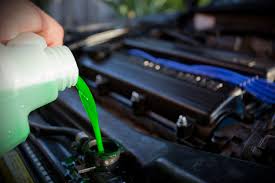The radiator is the major part of your vehicle that ensures that heat
which is the by-product of engine combustion is dissipated into the
surrounding air. Engine coolant is the liquid mixture formulated to
convey the excess heat from the engine to the radiator.
Our tropical weather dishes out constant punishment to car engines in form of extreme daily temperatures.
It is not only engine oil level that needs regular checks. Engine coolant is also a vital determinant of your engine’s health.
To
meet the power requirements of your vehicle, Fuel/air mixture is
ignited in the engine cylinders by the spark plugs. The resultant
combustion is what pushes the cylinders down to be converted to rotary
force by the crankshaft. The unwanted by-product is heat. Some of this
heat passes out through the exhaust system and some are retained in the
engine block.
This
heat is a waste product of the power being produced. If left
undissipated, the engine will quickly overheat and may result in seized
pistons or blown gaskets.
Since the surrounding air is much
cooler than the heated coolant in the radiator, the heat is dissipated
by the action of air being blown on the radiator during driving. This is
further enhanced by the action of a radiator fan that accelerates the
volume of air being blown on the radiator.
There are passageways
for engine coolant in the engine block and cylinder head, Hoses and
pipings are then used to convey the hot coolant to the radiator.
The
radiator contains piping and vanes conveying hot engine coolant from
the engine which is cooled and recycled back to engine in an endless
cycle to protect the engine from overheating.
Manufacturers recommend that you top up your engine with engine coolant and NOT water.
Water boils at around 100° C, or 212° F, boiling water can damage
the engine. A good engine coolant will raise this boiling point to
around 240° C (464° F).
Water will also corrode your engine’s coolant passageway.
The
benefits of using engine coolant includes prevention of rust and
corrosion in the metallic and rubber components of the engine that they
come in contact with, and a higher boiling point that is much desired in
a hot environment like ours.
It is good practice to check your
coolant level and possible leakages weekly and to keep an eye on your
engine temperature gauge while driving.
Engine coolant contains heat-inhibiting additives and are sometimes
coloured green or blue. Although other colours might be available.
Your
car might also have a reservoir for coolant, in which case you might be
advised to top-up the reservoir and not the radiator directly.
In
the unforeseen occurrence that your engine overheats and you are forced
to top up with water as an emergency coolant, your coolant will have
been diluted and may not provide the protection you expect.
Visit an automobile shop as soon as possible to have the entire coolant replaced.
by Akin Louis






